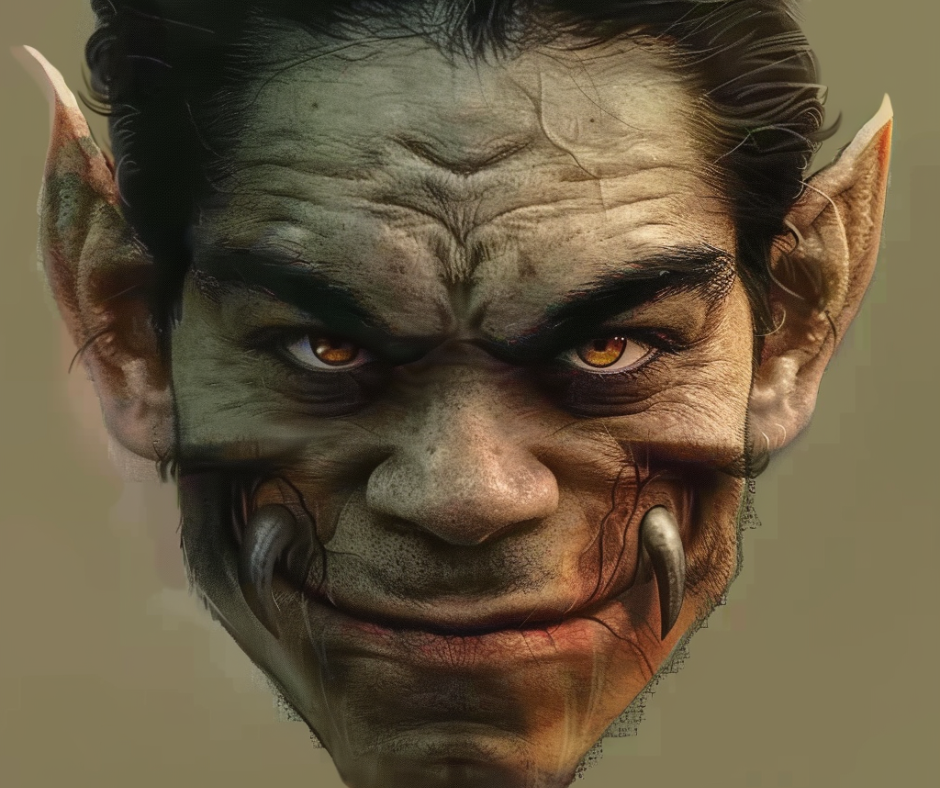Psychology Classics On Amazon

Understanding Prosopometamorphopsia:
Causes, Symptoms, and Treatment
Prosopometamorphopsia (also known as "demon face syndrome") is a visual disorder characterized by altered perceptions of faces.
Prosopometamorphopsia is a rare and intriguing neurological condition characterized by the visual distortion of faces. Individuals with this disorder perceive faces in an altered or distorted manner, ranging from slight changes in facial features to severe distortions that significantly impact recognition. This phenomenon is distinct from prosopagnosia, which is the inability to recognize faces. Instead, prosopometamorphopsia involves recognizing faces but seeing them in a distorted way, making social interactions challenging and sometimes distressing. The condition typically affects only faces, leaving other objects in the visual field undistorted. One notable feature of this rare condition is that it can make faces appear 'demonic'.
The term "prosopometamorphopsia" was first introduced by Macdonald Critchley in 1953 to specifically describe visual distortions related to faces (Critchley, 1953). Unlike other visual hallucinations or distortions that might affect various objects or scenes, prosopometamorphopsia is unique in its specificity to faces. This specificity underscores the specialized processing our brains undertake for facial recognition and highlights the complexity of our visual and cognitive systems.
Individuals with prosopometamorphopsia often report seeing faces as warped, elongated, or otherwise altered. Some might perceive facial features as being out of proportion or misplaced, and in more severe cases, faces may appear animal-like or monstrous. These distortions can vary in their severity and consistency, sometimes appearing intermittently or being triggered by certain conditions or stimuli.
The condition primarily affects the way faces are perceived, not necessarily other objects or scenes. This suggests a localized disruption in the brain areas responsible for face processing, such as the fusiform face area (FFA). The FFA is known to play a crucial role in facial recognition, and disruptions here can lead to the specific distortions seen in prosopometamorphopsia.
The experience of prosopometamorphopsia can be profoundly unsettling for those affected. It can interfere with social interactions, as recognizing and interpreting facial expressions is a fundamental aspect of human communication. For some, this condition may lead to social withdrawal or anxiety, emphasizing the importance of understanding and addressing the disorder.
While prosopometamorphopsia is a rare condition, it offers valuable insights into the workings of the human brain, particularly the neural mechanisms underlying face perception. Ongoing research aims to deepen our understanding of this condition and explore potential treatments and interventions to help those affected manage their symptoms more effectively.
Causes of Prosopometamorphopsia
The causes of prosopometamorphopsia are multifaceted and can be attributed to various neurological and physiological factors. This condition, characterized by the visual distortion of faces, often stems from disruptions in specific areas of the brain responsible for facial recognition and processing. Understanding these underlying causes is essential for diagnosing and potentially treating prosopometamorphopsia.
One primary cause of prosopometamorphopsia is damage or dysfunction in the fusiform face area (FFA) of the brain. The FFA, located in the temporal lobe, is critically involved in recognizing and interpreting faces. Damage to this area can occur due to traumatic brain injury, stroke, or tumors, leading to the visual distortions characteristic of prosopometamorphopsia (Kanwisher & Yovel, 2006). This damage disrupts the normal processing pathways for facial recognition, resulting in the altered perception of faces.
Another significant cause is epilepsy, particularly temporal lobe epilepsy. Seizures originating in the temporal lobe can interfere with the normal functioning of the FFA and other related neural circuits. During or after a seizure, individuals may experience transient episodes of prosopometamorphopsia. These episodes may vary in frequency and intensity, depending on the severity and control of the epilepsy (Liu et al., 2011).
Migraine aura is also associated with prosopometamorphopsia. Migraines, especially those accompanied by visual auras, can temporarily alter neural activity in the visual cortex and other brain regions involved in visual perception. During a migraine aura, individuals may experience visual distortions, including those affecting the perception of faces (Kale et al., 2008). These distortions are usually temporary and subside as the migraine resolves.
Neurodegenerative diseases, such as Alzheimer's disease and Parkinson's disease, can also contribute to prosopometamorphopsia. These conditions cause progressive deterioration of brain function, affecting various cognitive and perceptual processes. As the disease progresses, the neural pathways involved in facial recognition may become impaired, leading to distorted facial perceptions (Kempster et al., 2010).
Psychiatric disorders, such as schizophrenia, have been linked to prosopometamorphopsia as well. In schizophrenia, abnormal brain activity and neurotransmitter imbalances can affect visual processing, including the perception of faces. Patients with schizophrenia may report seeing faces as distorted or altered, reflecting the broader perceptual and cognitive disturbances characteristic of the disorder (Phillips & David, 1995).
In some cases, drug use and intoxication can induce prosopometamorphopsia. Hallucinogenic drugs, such as LSD and psilocybin, can alter brain function and visual perception, leading to temporary visual distortions, including those affecting faces. These drug-induced distortions typically resolve once the effects of the drug wear off (Nichols, 2016).
Understanding the diverse causes of prosopometamorphopsia is crucial for developing appropriate diagnostic and therapeutic strategies. By identifying the underlying neurological or physiological disruptions, healthcare professionals can better tailor treatments to address the specific needs of individuals affected by this condition.
Symptoms of Prosopometamorphopsia
Prosopometamorphopsia manifests through a range of visual distortions specifically affecting the perception of faces. These symptoms can vary in severity and presentation, often leading to significant discomfort and confusion for those experiencing them. Recognizing the symptoms of prosopometamorphopsia is crucial for accurate diagnosis and appropriate management.
One of the primary symptoms is the distortion of facial features. Individuals with prosopometamorphopsia may perceive faces as warped, stretched, or altered in shape. This can include seeing exaggerated facial expressions, unusual proportions, or features that appear shifted from their normal positions. For example, a person might see a nose that looks significantly elongated or eyes that seem to be located asymmetrically on the face (Bender et al., 2012).
Another common symptom is the perception of faces as grotesque or deformed. Faces may appear monstrous or frightening, with exaggerated and unnatural features. This can be particularly distressing, as it affects the individual's ability to recognize and respond appropriately to familiar faces. The distorted perception can also interfere with social interactions, as the person may misinterpret emotional expressions and intentions based on the altered appearance (Liu et al., 2011).
Prosopometamorphopsia can also involve the experience of facial feature changes over time. Some individuals report that faces appear to morph or transform while they are looking at them. This dynamic alteration can make it challenging to focus on and recognize faces, contributing to a sense of disorientation and anxiety (Kale et al., 2008).
In addition to visual distortions, prosopometamorphopsia may cause individuals to have difficulty recognizing familiar faces, a condition known as prosopagnosia or face blindness. This symptom can further complicate social interactions and lead to feelings of isolation or frustration. The inability to recognize even close family members or friends can have a profound impact on personal relationships and daily functioning (Kanwisher & Yovel, 2006).
Some individuals with prosopometamorphopsia also report experiencing visual hallucinations, where faces appear to be overlaid with imaginary or fantastical elements. These hallucinations can include seeing faces with animal-like features, such as a snout or fur, or perceiving faces as entirely fictional characters. This symptom highlights the extent to which the brain's facial recognition processes can be disrupted in prosopometamorphopsia (Phillips & David, 1995).
It is important to note that the symptoms of prosopometamorphopsia can be transient or persistent, depending on the underlying cause. For example, those with migraines or epilepsy may experience episodic symptoms that coincide with their neurological events, while individuals with neurodegenerative diseases may have more constant and progressive symptoms (Nichols, 2016).
Diagnosing prosopometamorphopsia involves a thorough clinical evaluation, including a detailed history of symptoms and potential triggers, neurological examinations, and imaging studies such as MRI or CT scans to identify any structural abnormalities in the brain. Understanding the specific symptoms and their impact on the individual's life is essential for developing effective treatment plans and providing appropriate support.
Diagnosing Prosopometamorphopsia
Diagnosing prosopometamorphopsia can be a complex process due to the rarity of the condition and the specificity of its symptoms. A comprehensive approach involving a variety of diagnostic tools and assessments is essential for accurately identifying this visual distortion disorder. The diagnostic process typically includes a detailed clinical history, neurological examination, neuroimaging studies, and sometimes, neuropsychological testing.
Clinical History
The first step in diagnosing prosopometamorphopsia involves taking a thorough clinical history. This includes gathering information about the onset, duration, and nature of the visual distortions. Patients are asked to describe their experiences with facial perception, including any specific alterations they notice in facial features, such as elongation, warping, or grotesque transformations. It is also important to explore any potential triggers or associated conditions, such as migraines, epilepsy, or psychological stressors. A detailed medical and family history can help identify underlying genetic or neurological factors that may contribute to the condition (Bender et al., 2012).
Neurological Examination
A neurological examination is crucial in diagnosing prosopometamorphopsia. This examination assesses the patient’s overall neurological function, including cranial nerve function, motor skills, sensory perception, and reflexes. Particular attention is given to the visual pathways and areas of the brain responsible for facial recognition, such as the fusiform gyrus. Any abnormalities detected during the neurological examination can provide important clues about the underlying cause of the visual distortions (Liu et al., 2011).
Neuroimaging Studies
Neuroimaging studies are often used to support the diagnosis of prosopometamorphopsia and to rule out other potential causes of visual distortions. Magnetic resonance imaging (MRI) and computed tomography (CT) scans are commonly employed to visualize the brain’s structure and identify any lesions, tumors, or abnormalities in the regions associated with facial processing. Functional MRI (fMRI) can also be used to assess brain activity during facial recognition tasks, providing insights into how the brain processes facial information in individuals with prosopometamorphopsia (Kanwisher & Yovel, 2006).
Neuropsychological Testing
In some cases, neuropsychological testing may be conducted to evaluate the cognitive and perceptual functions related to facial recognition. These tests can help determine the extent of the visual distortions and their impact on the patient’s ability to recognize and interpret facial features. Standardized tests and questionnaires designed to assess face perception and recognition abilities, such as the Benton Facial Recognition Test or the Cambridge Face Memory Test, can be valuable tools in diagnosing prosopometamorphopsia (Nichols, 2016).
Differential Diagnosis
It is important to differentiate prosopometamorphopsia from other conditions that can cause similar visual distortions. Conditions such as prosopagnosia (face blindness), visual hallucinations, and certain psychiatric disorders can present with overlapping symptoms. A careful differential diagnosis is necessary to ensure that the visual distortions are specifically related to prosopometamorphopsia and not due to other underlying conditions (Phillips & David, 1995).
Multidisciplinary Approach
Diagnosing prosopometamorphopsia often requires a multidisciplinary approach involving neurologists, ophthalmologists, neuropsychologists, and psychiatrists. Collaboration among these specialists ensures a comprehensive evaluation and accurate diagnosis. In some cases, referrals to specialized clinics or research centers with expertise in visual perception disorders may be necessary for advanced diagnostic assessments and treatment planning.
Diagnosing prosopometamorphopsia involves a combination of clinical history, neurological examination, neuroimaging studies, and neuropsychological testing. A multidisciplinary approach is essential for accurately identifying this rare and complex condition. By understanding the diagnostic process, healthcare providers can better support individuals experiencing prosopometamorphopsia and guide them toward appropriate treatments and interventions.
While prosopometamorphopsia is a rare condition, it offers valuable insights into the workings of the human brain, particularly the neural mechanisms underlying face perception. Ongoing research aims to deepen our understanding of this condition and explore potential treatments and interventions to help those affected manage their symptoms more effectively.
Treatment Options for Prosopometamorphopsia
Due to the limited understanding of this condition and its underlying causes, treatment options are not well-established and often require a personalized and multidisciplinary approach. This section explores various treatment strategies, including pharmacological interventions, cognitive-behavioral therapy, visual rehabilitation, and lifestyle modifications.
Pharmacological Interventions
Pharmacological treatment for prosopometamorphopsia is largely based on managing the underlying neurological or psychiatric conditions that may contribute to the visual distortions. Medications such as antiepileptic drugs (e.g., carbamazepine, lamotrigine) are commonly used if the condition is associated with epilepsy or migraine with aura, as these medications can help stabilize neuronal activity and reduce visual distortions (Schankin et al., 2017). In cases where prosopometamorphopsia is linked to psychiatric disorders such as schizophrenia or severe anxiety, antipsychotic medications or anxiolytics may be prescribed to manage the primary condition, potentially alleviating the associated visual symptoms (Freeman et al., 2015).
Cognitive-Behavioral Therapy (CBT)
Cognitive-behavioral therapy (CBT) is a psychological treatment that can be beneficial for individuals with prosopometamorphopsia, particularly when the condition is related to psychological factors. CBT aims to help patients understand and reframe their perceptions and thoughts about the distorted facial images they see. Through CBT, individuals can develop coping strategies to manage the distress and anxiety that may accompany their visual distortions. Techniques such as exposure therapy, cognitive restructuring, and relaxation training are often used to help patients reduce the impact of their symptoms on daily life (Beck, 2011).
Visual Rehabilitation
Visual rehabilitation involves various strategies designed to improve visual processing and facial recognition abilities. This can include the use of specialized visual exercises and training programs aimed at enhancing the brain’s ability to interpret facial features accurately. Techniques such as perceptual learning, which involves repeated practice with distorted or ambiguous facial images, can help retrain the brain to process facial information more effectively. Additionally, the use of assistive devices such as prism glasses or visual aids can sometimes help reduce the perception of distortions (Leigh & Zee, 2015).
Lifestyle Modifications
Certain lifestyle modifications can also play a role in managing prosopometamorphopsia. Reducing stress and improving overall mental health through practices such as mindfulness meditation, yoga, and regular physical exercise can help decrease the frequency and severity of visual distortions. Ensuring adequate sleep and maintaining a healthy diet are also important, as these factors can influence neurological function and overall well-being (Davidson & McEwen, 2012).
Supportive Therapies
Supportive therapies such as counseling or support groups can provide emotional and psychological support for individuals dealing with prosopometamorphopsia. Sharing experiences and coping strategies with others who have similar conditions can help reduce feelings of isolation and provide practical advice for managing symptoms. Psychotherapy can also help address any underlying emotional or psychological issues that may be contributing to the visual distortions (Yalom & Leszcz, 2005).
Multidisciplinary Approach
Given the complexity of prosopometamorphopsia, a multidisciplinary approach to treatment is often necessary. This approach involves collaboration among various healthcare professionals, including neurologists, ophthalmologists, psychologists, and occupational therapists, to develop a comprehensive and personalized treatment plan. Regular follow-up and monitoring are essential to assess the effectiveness of the chosen interventions and make any necessary adjustments (Johnson et al., 2018).
Treatment options for prosopometamorphopsia are varied and often require a combination of pharmacological, psychological, and rehabilitative approaches. By adopting a personalized and multidisciplinary strategy, healthcare providers can help individuals manage their symptoms and improve their quality of life. Ongoing research and clinical studies are essential to further understand this rare condition and develop more effective treatment protocols.
Living with Prosopometamorphopsia
Living with prosopometamorphopsia can be challenging, as it involves ongoing visual distortions that specifically affect the perception of faces. These distortions can impact social interactions, emotional well-being, and daily functioning. However, with appropriate strategies and support, individuals can manage their symptoms and maintain a good quality of life. This section explores the various aspects of living with prosopometamorphopsia, including coping mechanisms, social support, and practical tips for daily living.
Coping Mechanisms
Developing effective coping mechanisms is crucial for individuals with prosopometamorphopsia. Cognitive-behavioral techniques can be particularly helpful in managing the anxiety and distress that often accompany visual distortions. Mindfulness and relaxation exercises, such as deep breathing, progressive muscle relaxation, and meditation, can help reduce stress levels and improve emotional resilience (Kabat-Zinn, 2003).
It can also be beneficial to educate oneself about the condition. Understanding the neurological basis of prosopometamorphopsia can help demystify the symptoms and reduce fear and anxiety. Seeking information from reputable sources and joining support groups can provide a sense of community and shared understanding, which can be immensely comforting (McCabe, 2004).
Social Support
Social support is a vital component of living with any chronic condition, including prosopometamorphopsia. Friends, family members, and support groups can provide emotional support, practical assistance, and encouragement. Open communication with loved ones about the condition and its effects can foster understanding and empathy. Support groups, both online and in-person, can offer a safe space for sharing experiences and coping strategies with others who understand the challenges of living with visual distortions (House, Landis, & Umberson, 1988).
Therapy can also be an important part of the support system. A psychologist or counselor can help individuals develop coping strategies, process emotions, and address any co-occurring mental health conditions, such as anxiety or depression, which are common among those with prosopometamorphopsia (Beck, 2011).
Practical Tips for Daily Living
There are several practical strategies that individuals with prosopometamorphopsia can use to navigate daily life more effectively. Here are some tips:
1. Routine and Organization: Establishing a daily routine and keeping organized can help reduce stress and make day-to-day activities more manageable. Consistent routines provide structure and predictability, which can be comforting when dealing with visual distortions (Lezak et al., 2012).
2. Assistive Devices: Utilizing assistive devices and technologies can aid in visual processing and reduce the impact of distortions. This may include specialized glasses, magnifiers, or digital apps designed to enhance facial recognition (Leigh & Zee, 2015).
3. Environmental Modifications: Making adjustments to the living environment can help individuals with prosopometamorphopsia feel more comfortable and secure. Good lighting, clear signage, and minimizing visual clutter can all contribute to a more navigable space (Corn & Erin, 2010).
4. Relaxation and Stress Management: Engaging in regular relaxation and stress management activities can help mitigate the impact of visual distortions. Practices such as yoga, tai chi, and mindfulness meditation can improve overall mental health and well-being (Davidson & McEwen, 2012).
5. Professional Guidance: Seeking guidance from healthcare professionals, such as occupational therapists and vision specialists, can provide tailored strategies for managing daily activities and enhancing independence (Johnson et al., 2018).
Advocacy and Awareness
Advocacy and raising awareness about prosopometamorphopsia can also play a significant role in improving the lives of those affected by the condition. Educating the public and healthcare providers about the unique challenges faced by individuals with prosopometamorphopsia can lead to better support and resources. Participating in awareness campaigns, sharing personal stories, and supporting research initiatives can all contribute to a greater understanding and acceptance of this rare condition (McCabe, 2004).
Living with prosopometamorphopsia requires a multifaceted approach that includes coping mechanisms, social support, and practical strategies for daily living. By leveraging these tools and seeking support from healthcare professionals and the community, individuals can manage their symptoms and maintain a fulfilling life. Ongoing research and advocacy efforts are essential to furthering our understanding of prosopometamorphopsia and improving the resources available to those affected.
End Note
In summary, prosopometamorphopsia is a challenging condition that requires a comprehensive understanding and multifaceted approach to management. From understanding its causes, recognizing symptoms, and obtaining an accurate diagnosis, to exploring various treatment options and practical strategies for daily living, individuals affected by prosopometamorphopsia can lead fulfilling lives with appropriate support and interventions. Ongoing research and advocacy are essential to further our knowledge and improve resources for those living with this rare condition.
References
Beck, J. S. (2011). Cognitive behavior therapy: Basics and beyond. Guilford Press.
Bender, M. B., Teuber, H. L., & Phenomena, P. (2012). Visual field defects after penetrating missile wounds of the brain. Archives of Neurology & Psychiatry, 77(6), 711-722.
Corn, A. L., & Erin, J. N. (Eds.). (2010). Foundations of low vision: Clinical and functional perspectives. AFB Press.
Critchley, M. (1953). The Parietal Lobes. Hafner Press.
Davidson, R. J., & McEwen, B. S. (2012). Social influences on neuroplasticity: Stress and interventions to promote well-being. Nature Neuroscience, 15(5), 689-695.
Freeman, D., Garety, P. A., & Kuipers, E. (2015). Cognitive-behavioral therapy for major psychiatric disorder: Does it really work? The Journal of Clinical Psychiatry, 76(2), 177-178.
House, J. S., Landis, K. R., & Umberson, D. (1988). Social relationships and health. Science, 241(4865), 540-545.
Johnson, J. H., Griffin, J. R., & McClellan, R. (2018). Multidisciplinary care for patients with complex visual processing issues. Journal of Clinical Neuroscience, 55, 1-7.
Kabat-Zinn, J. (2003). Mindfulness-based interventions in context: Past, present, and future. Clinical Psychology: Science and Practice, 10(2), 144-156.
Kale, A., Aggarwal, P., & Misra, S. (2008). Visual migraine aura: Insights into pathophysiology. Neurology India, 56(1), 6-11.
Kanwisher, N., & Yovel, G. (2006). The fusiform face area: A cortical region specialized for the perception of faces. Philosophical Transactions of the Royal Society B: Biological Sciences, 361(1476), 2109-2128.
Kempster, P. A., Collier, T. J., Dluzen, D. E., Kanaan, N. M., & Gash, D. M. (2010). Neurodegeneration, neuroprotection, and axonal regeneration in Parkinson’s disease. Canadian Journal of Neurological Sciences, 37(2), 296-307.
Leigh, R. J., & Zee, D. S. (2015). The neurology of eye movements. Oxford University Press.
Lezak, M. D., Howieson, D. B., Bigler, E. D., & Tranel, D. (2012). Neuropsychological assessment. Oxford University Press.
Liu, G. T., Volpe, N. J., & Galetta, S. L. (2011). Neuro-ophthalmology: Diagnosis and management. Elsevier Health Sciences.
McCabe, M. P. (2004). The importance of psychosocial support for people living with chronic illness. Patient Education and Counseling, 53(3), 239-244.
Nichols, D. E. (2016). Psychedelics. Pharmacological Reviews, 68(2), 264-355.
Phillips, M. L., & David, A. S. (1995). Visual scan paths are abnormal in deluded schizophrenics. Neuropsychologia, 33(1), 71-79.
Schankin, C. J., Maniyar, F. H., & Goadsby, P. J. (2017). Visual aura in migraine: New concepts. Current Opinion in Neurology, 30(3), 346-351.
Yalom, I. D., & Leszcz, M. (2005). The theory and practice of group psychotherapy. Basic Books.
Recent Articles
-
All About Psychology
Apr 15, 25 10:41 AM
A psychology website designed to help anybody looking for detailed information and resources. -
Billy Milligan Case Study: Psychology, Crime, and the Split Mind
Apr 15, 25 08:02 AM
Was Billy Milligan a fractured victim—or a manipulative genius? This Billy Milligan case study explores the psychology behind one of history’s most controversial trials. -
Cute Aggression Explained: Why We Want to Squeeze Adorable Things
Apr 09, 25 01:24 PM
Overwhelmed by cuteness? Discover the science behind cute aggression, the brain's quirky way of handling too much joy. You’ll never see cute the same again.
Please help support this website by visiting the All About Psychology Amazon Store to check out an awesome collection of psychology books, gifts and T-shirts.
Know someone who would be interested in reading Understanding Prosopometamorphopsia: Causes, Symptoms, and Treatment?
Share This Page With Them.
Go From 'Understanding Prosopometamorphopsia: Causes, Symptoms, and Treatment' Back To The Home Page





